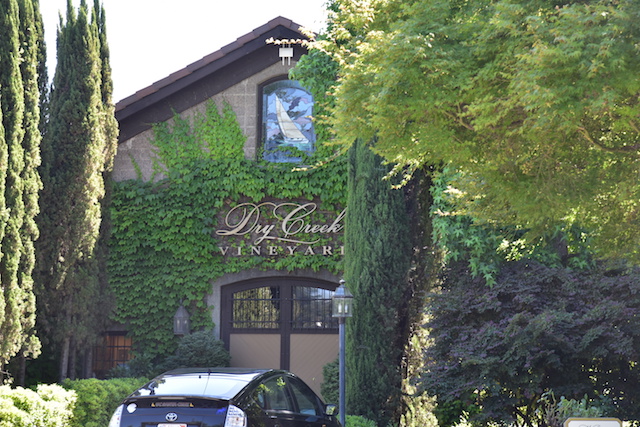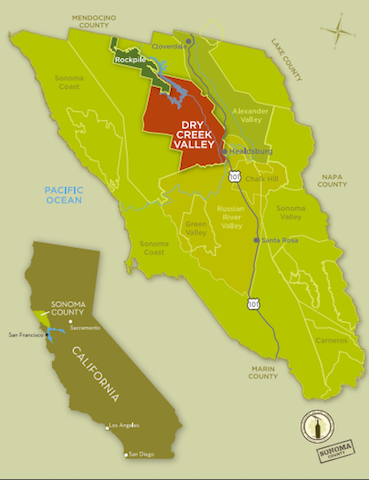Posted: Jul 04, 2018

Winegrowers of Dry Creek Valley, the voluntary organization of winemakers and growers in Sonoma’s Dry Creek Valley AVA, held an event recently to explain who they were and what Dry Creek is. I attended the day long event and admit, I had to scratch my head to prise out what defined them.
I knew that Dry Creek Valley AVA occupies a scant strip 16 miles long by three miles wide. Hills on either side edge a flat valley in the center. Irrigation is via Dry Creek out of Lake Sonoma. Until the 1960s the most prominent crop was not grapes, but prunes. The story of agriculture in the Valley since prohibition can be written as the ascendency of grapes and the premiumization of the wines made from them.
The Winegrowers of Dry Creek Valley have put together a 20 minute video that helps. I was struck that grape growing goes back 150 years to the arrival of (mainly Italian) immigrants who brought in agricultural skills. The Mauritson Family can actually trace their history back the full 150 years. Ted Seghesio describes how his great grandfather came over at the request of his friend Carlo Rossi who ran Italian Swiss Colony in part as a work and housing coop for newly arriving immigrants. Other grape growing families followed but they were a minority in a valley where prunes were king until the 1960s. Most growers sold grapes to Gallo or made bulk wine under generic names like ‘Red’ and ‘White’ or appropriated names like ‘Chablis’. The grapes were Zinfandel, Carignane, Petit Sirah, Malvasia, Alicante Bouchet, and a French variety named Burger that, in the words of Dane Petersen of Fall Creek Vineyards (not to be confused with the Texas winery of the same name) was “high tons per acre...but just kinda’ poor wine”.

A breakthrough occurred in 1972 when a Boston engineer, David Stare, opened Dry Creek Vineyard and went to the local growers to buy grapes for wines he planned to label as being from Dry Creek Valley. By doing so he made two seminal contributions. First, he put the valley’s name on the bottle. Second, his first labels were rejected by the BATF (the Federal Bureau of Alcohol, Tobacco, and Firearms) on the grounds that Dry Creek Valley was not an approved appellation. He persuaded them to let him use up his existing stock of labels but they stipulated that he could not use the name again. That prompted producers like Stare, Pedroncelli, Rafanelli, and Preston getting together and creating the application for the Dry Creek Valley AVA, which was approved in 1983.
The modern era brings new challenges. I asked several members of the Winegrowers where a small area comprised of family wineries fits in the global market. They see the valley producing super premium wines across several varietals. Although Zinfandel is is the red grape with which the area is most identified (and just last year outproduced Cabernet Sauvignon in the valley with 28% of plantings vs. 24% of Cabernet Sauvignon) they don’t want to put all their eggs (or grapes) in one basket. Memories are still fresh of the Zinfandel market’s ebb and flow in the past. Ted Seghesio is pleased that the style has moved away from the ‘portlike’ monsters of the noughties. So much so that he organized a blind tasting of full-bodied red wines from around the world, led by Master Sommelier Tim Gaiser, to show how Zinfandel deserved a place at that table.
BLIND TASTING: SEGHESIO ZINFANDEL VERSUS OTHER RED WINES OF THE WORLD |
|
2011 Seghesio Family Vineyards, Home Ranch Zinfandel, Alexander Valley, Sonoma County, CA $58 |
|
2011 Domaine Vincent Paris Cornas Granit 60 Vieilles Vignes, France (from northern Rhðne Valley) $65 |
|
2009 Henschke Keyneton Estate Euphonium Red Bland, Eden Valley, Barossa, Australia $65 |
|
2007 Altesino Brunello di Montalcino, Montalcino, Tuscany, Italy $65 |
|
2007 Cheval des Andes, Luján de Cuyo, Mendoza, Argentina $80 |
|
2010 Turley Wine Cellars Cedarman Zinfandel, Howell Mountain, Napa Valley, CA $50 |
Shelly Rafanelli, fourth generation winemaker at Rafanelli Winery, describes modern Dry Creek Zinfandel as more complex and refined than the wines of a decade ago. Rafanelli is picking earlier to keep sugars down and ageing in 100% French oak (one third new) for a year to develop flavors. She isn’t ready to declare that her Zinfandel will age as well as her Cabernet, but says that it will age better than Zinfandel did in the past. Another family to watch, if you can get past the animated squirrels on their home page, is Nalle Winery. An interesting expression of Zinfandel was a rosé from Pedroncelli. It was a refreshing change of pace on the hot day that I tasted it.
The other leadership red grape is Cabernet Sauvignon. I found compelling examples from Rued Vineyard and Rafanelli (where 22 months in 100% new French oak is the ageing regimen). At Dry Creek Vineyard Partner Don Wallace took me through a stair-step tasting of Cabernet-based blends that showed finesse and distinctiveness rivalling Cabernets from anywhere in California.
There are over 30 other varieties of grapes in smaller quantities. Mounts Family Winery, a longtime grower turned winemaker, served a fragrant and mouth filling wine that might be called a GSMC, where the ‘C’ stands for Counoise, under their Verah label.
Among white grapes the leader is Sauvignon Blanc, with seemingly everybody growing it. Check out the Mill Creek Winery Vera’s Block, or the Mauritson Wines, or Pedroncelli East Side Vineyard for good examples. Several producers make Chardonnay (and it is the third most planted grape at 11% of acreage) but some consider Dry Creek simply too warm for the grape. In some cases, e.g. Dry Creek Vineyard, they source their Chardonnay grapes from the Russian River AVA. There are also smatterings of Gewurztraminer, Pinot Grigio and Viognier.

New wineries have opened in Dry Creek Valley to the point that there are now over 50. However, family ownership by the founding families has remained an enduring fact. Certainly, there is a corporate presence (e.g. Gallo, which is a big buyer of Dry Creek fruit) but it is the family-owned wineries who define the character of the valley in the modern era.
So what does Dry Creek Valley actually mean? It is predominantly, but not exclusively, Zinfandel. It is some of the best Zinfandel, maybe the best Zinfandel, in the world. Cabernet is a sleeper, but deceptively good to the point of destroying tasting reputations if snuck in blind at a Napa Cabernet event. It is Sauvignon Blanc, made in a style that people have come to call ‘New World’ that comes out, apparently effortlessly, from these vineyards. It is family-owned, small, boutique wineries where, to borrow a phrase, everyone knows everybody. It is an area where wine clubs and ongoing relationships figure prominently.
By Andrew Chalk
July 4, 2018
Go-Wine's mission is to organize food and beverage information and make it universally accessible and beneficial. These are the benefits of sharing your article in Go-Wine.com


The Wine Thief Bistro & Specialty Wines is a locally owned small business in downtown Frankfort, IL offering world class wines in a relaxed, casual gathering spot for friends and family. Offering world class virtual tastings and touchless carryout.
https://www.twtwineclub.com/aboutus
Go-Wine 25 Great Wineries in US selection prioritizes quality, value and availability.
www.go-wine.com/great-wineries-in-america
Tasting wine is a nice experience, but visiting the places in which wine is made is a magic moment. Available in New York City for touchless pickup.